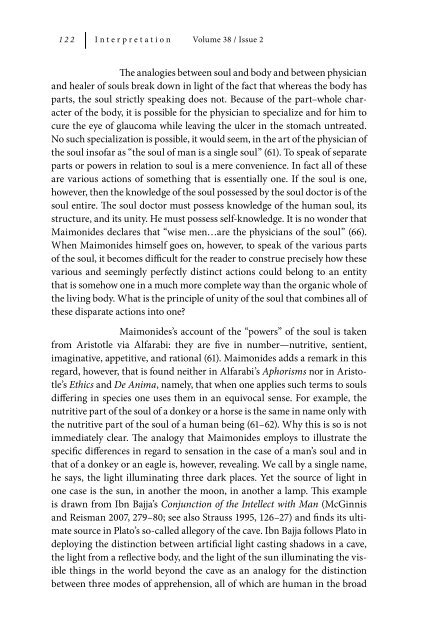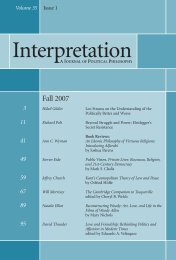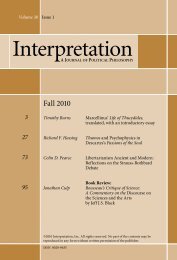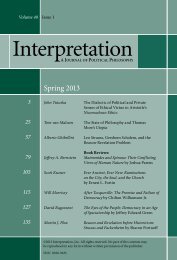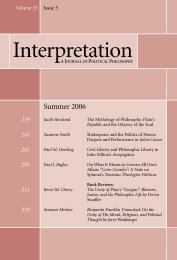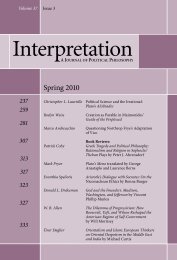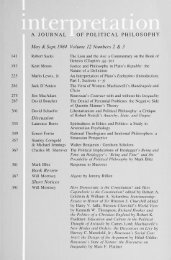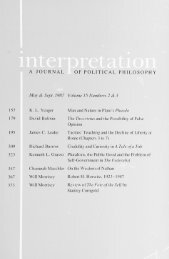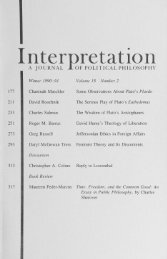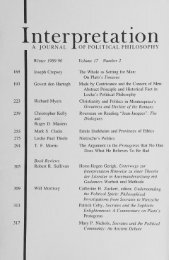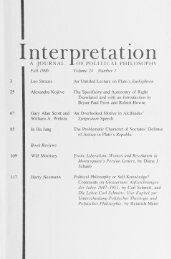105 119 147 171 177 197 - Interpretation: A Journal of Political ...
105 119 147 171 177 197 - Interpretation: A Journal of Political ...
105 119 147 171 177 197 - Interpretation: A Journal of Political ...
You also want an ePaper? Increase the reach of your titles
YUMPU automatically turns print PDFs into web optimized ePapers that Google loves.
1 2 2 I n t e r p r e t a t i o n Volume 38 / Issue 2<br />
The analogies between soul and body and between physician<br />
and healer <strong>of</strong> souls break down in light <strong>of</strong> the fact that whereas the body has<br />
parts, the soul strictly speaking does not. Because <strong>of</strong> the part–whole character<br />
<strong>of</strong> the body, it is possible for the physician to specialize and for him to<br />
cure the eye <strong>of</strong> glaucoma while leaving the ulcer in the stomach untreated.<br />
No such specialization is possible, it would seem, in the art <strong>of</strong> the physician <strong>of</strong><br />
the soul ins<strong>of</strong>ar as “the soul <strong>of</strong> man is a single soul” (61). To speak <strong>of</strong> separate<br />
parts or powers in relation to soul is a mere convenience. In fact all <strong>of</strong> these<br />
are various actions <strong>of</strong> something that is essentially one. If the soul is one,<br />
however, then the knowledge <strong>of</strong> the soul possessed by the soul doctor is <strong>of</strong> the<br />
soul entire. The soul doctor must possess knowledge <strong>of</strong> the human soul, its<br />
structure, and its unity. He must possess self-knowledge. It is no wonder that<br />
Maimonides declares that “wise men…are the physicians <strong>of</strong> the soul” (66).<br />
When Maimonides himself goes on, however, to speak <strong>of</strong> the various parts<br />
<strong>of</strong> the soul, it becomes difficult for the reader to construe precisely how these<br />
various and seemingly perfectly distinct actions could belong to an entity<br />
that is somehow one in a much more complete way than the organic whole <strong>of</strong><br />
the living body. What is the principle <strong>of</strong> unity <strong>of</strong> the soul that combines all <strong>of</strong><br />
these disparate actions into one?<br />
Maimonides’s account <strong>of</strong> the “powers” <strong>of</strong> the soul is taken<br />
from Aristotle via Alfarabi: they are five in number—nutritive, sentient,<br />
imaginative, appetitive, and rational (61). Maimonides adds a remark in this<br />
regard, however, that is found neither in Alfarabi’s Aphorisms nor in Aristotle’s<br />
Ethics and De Anima, namely, that when one applies such terms to souls<br />
differing in species one uses them in an equivocal sense. For example, the<br />
nutritive part <strong>of</strong> the soul <strong>of</strong> a donkey or a horse is the same in name only with<br />
the nutritive part <strong>of</strong> the soul <strong>of</strong> a human being (61–62). Why this is so is not<br />
immediately clear. The analogy that Maimonides employs to illustrate the<br />
specific differences in regard to sensation in the case <strong>of</strong> a man’s soul and in<br />
that <strong>of</strong> a donkey or an eagle is, however, revealing. We call by a single name,<br />
he says, the light illuminating three dark places. Yet the source <strong>of</strong> light in<br />
one case is the sun, in another the moon, in another a lamp. This example<br />
is drawn from Ibn Bajja’s Conjunction <strong>of</strong> the Intellect with Man (McGinnis<br />
and Reisman 2007, 279–80; see also Strauss 1995, 126–27) and finds its ultimate<br />
source in Plato’s so-called allegory <strong>of</strong> the cave. Ibn Bajja follows Plato in<br />
deploying the distinction between artificial light casting shadows in a cave,<br />
the light from a reflective body, and the light <strong>of</strong> the sun illuminating the visible<br />
things in the world beyond the cave as an analogy for the distinction<br />
between three modes <strong>of</strong> apprehension, all <strong>of</strong> which are human in the broad


